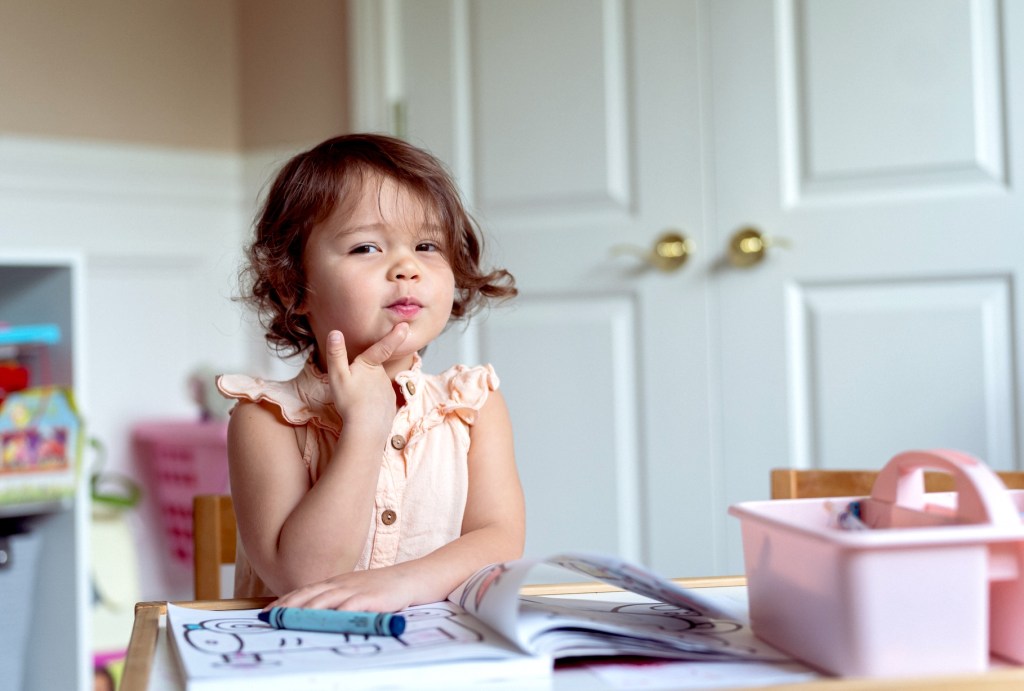Toddlers have a lot to think about: Which toy is their favorite? What sound does a cow make? Why can’t they eat that sticky fruit snack that fell on the floor? The ability to evaluate probabilities and possibilities, though, might seem a bit outside their wheelhouse.
As adults, we’re used to analyzing the likelihood of events. If 181 million people are playing Powerball, we know (despite all hope we’re wrong) that we’re probably not going to win. But we also know if we don’t buy a ticket at all, it’s impossible for us to win. And according to a first-of-its-kind study, toddlers practice the same type of mental judgment.
“Even young toddlers already think about the world in terms of possibilities,” co-author Lisa Feigenson, co-director of the Johns Hopkins University Laboratory for Child Development, said in a news release.
To arrive at the conclusion, Feigenson set up an adorable experiment. She and fellow co-author Aimee Stahl knew they’d need something that could catch and hold the attention of such young children, so they created a special gumball-type machine filled with toys.
“It turns out that the opportunity to put a little coin in a machine and get a prize is very naturally motivating to kids,” Feigenson told NPR.
Children ages 2 and 3 were shown a transparent gumball machine that looked to either be filled with a mix of pink and purple toys, or only purple toys. Unbeknownst to the young participants, the toy they would ultimately receive couldn’t be seen and was preloaded into the chute.
Whatever object came out when they inserted their coin, the little ones were told it was called a “blick.” Later on, they were asked to identify the “blick” in a lineup of toys.
When kids who saw a mix of pink and purple toys wound up with a pink one, they seemed unsurprised at the prize and typically forgot its made-up name. This was the case even if they could see only one pink toy amid many purple toys, and thus their receiving it was improbable.
But if the toddlers received a pink toy when the machine appeared to contain none at all — a seemingly impossible occurrence — their reactions were much different.
Frequently, “kids’ eyes get wide, and their jaws drop, and they look at their mom in surprise that this has happened,” Feigenson said. And when this happened, those children usually remembered the toy’s name.
The outcomes indicate that not only can children appreciate probabilities, but also that they learn better from experiencing seemingly impossible events than from experiencing likely or unlikely events.
“One possibility was that they would learn well from the improbable events, but even better from the impossible events,” Stahl explained in the Hopkins release. “But what we found was that they actually don’t learn from the unlikely, improbable events. They only learn if they experienced the impossible event.”
And she and Feigenson have an idea of why that’s so.
“We think that ‘impossible events’ — or events that totally contradict our mental models of the world around us — launch us into the search for explanations,” Feigenson told ZME Science.
“These results are so interesting because they show that when children see events in the world that they can’t explain, it instills in them a drive for information that they can use to reconcile their prior model of the world with what they’ve just seen,” she added in the news release. “Scientifically, these findings are exciting because they suggest that humans are equipped from the get-go to think about whether things are possible or unlikely or just can’t happen.”
RELATED: Altruism, Empathy Toward Animals Begins at an Early Age for Many, Study Finds
That said, toddlers are still likely to deny the possibility of abstract concepts that go against their, rather limited, belief system. Speaking to NPR, Andrew Shtulman, a professor at Occidental College who was not involved in the study, gave the example of kids hearing a story that mentioned pickle-flavored ice cream.
He asserted that even 4-year-olds would likely refuse to believe that such a ridiculous (in their minds) ice cream flavor could exist. Unless they see evidence to the contrary, he said, “anything that violates their expectations, they deny is possible.” He noted that, as this study and others before it suggest, a way to get them to really key in and learn something is to produce that improbable evidence prior to introducing the information.
In that sense, the body of research is particularly exciting for the potential it holds to inform learning modes. As Feigenson pointed out in the Hopkins release: “Parents and educators can create opportunities for children to really puzzle over something they find mysterious to offer a really powerful moment for learning to occur.”











